Open House
Just under a year after the closure of its predecessor, on October 1, 1999, Journey into Your Imagination opened at Epcot. Aside from the addition of the word “YOUR” to the ride’s marquee outside, very little hints that the ride experience inside is any different. The Imagination pavilion is still made of two towering glass pyramids, with fountains leaping fantastically between planters outside.

But now, the ride’s maquee – a banner strung over its entrance – is joined by waving flags emblazoned with… eye charts? Yes, things have changed. Now, our Journey into Imagination has changed from an abstract musical journey through arts and literature into an open house tour of the Imagination Institute. Yes, while we might have seen the Institute’s auditorium in “Honey, I Shrunk the Audience” next door, this is our chance to enter the Institute’s labs themselves in a rare peak behind the scenes.
For that reason, the queue is no longer a whimsical, sunlit atrium of pastel abstraction… It’s the very real, very concrete lobby and waiting room of the Imagination Institute itself. The red carpet has been proverbially and literally unfurled, with guests making their way through the reception area.

Okay, so we’d firmly place this so far into being a surefire giveaway of a “bad” ride narrative. The idea of rooting a guest’s experience by framing it as a “tour” or a mere “training exercise” is a famously frustrating cop-out when Imagineers don’t trust guests to … well… use their imaginations and instead feel the need to ground a narrative with continuous reminders that we’re merely in a faked scenario in a theme park. Of course, it would’ve helped if the “Honey, I Shrunk the Audience” references weren’t already a decade old by time this new dark ride incarnation opened.
The point is, the pun-filled queue line for the Imagination Institute helps us understand that our job today is a simple one: we’ll be testing out the Institute’s new “Imagination Scanner,” capable of telling us just how creative we are.
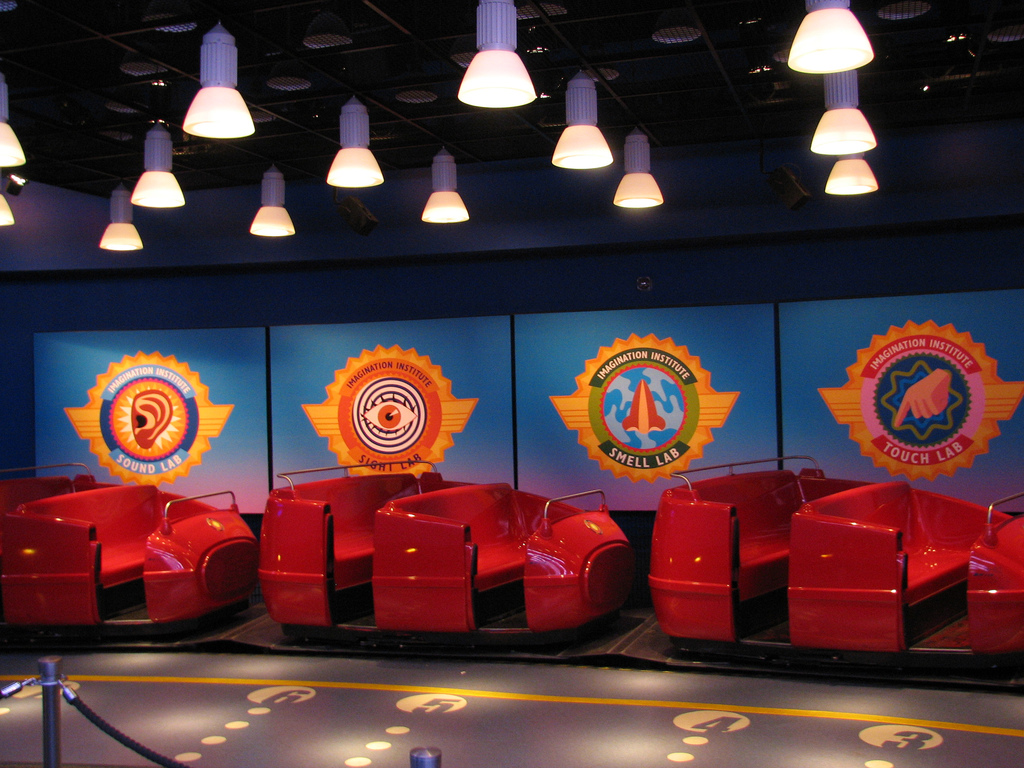
As we arrive at the end of the queue, a familiar chain of Omnimover vehicles pulls into the load area to prepare for boarding. While they might not have changed much, something has. Don’t expect your grand journey to begin on the iconic engineering marvel of the massive revolving turntable scene. Why? Because you’re standing on it.
The first thing to know about Journey into Your Imagination is that Kodak’s modest investment couldn’t quite cover Tony Baxter’s original 12-minute epic dark ride. The original track layout has been altered.
Now, the former turntable scene where we first met Dreamfinder serves as the unload and load area. A further 40% of the ride’s track has been physically severed from the circuit – a portion became the queue we just passed through, while the former finale and load/unload became the ImageWorks post-show, relocated from its sunlit spot in the pyramids. Half of the ride’s vehicles have been cut not only to accomodate for the shortened circuit, but to allow stopped show scenes throughout.
The former 12-minute dark ride is now 5 minutes long. Seriously. (Use the slider above to compare.)
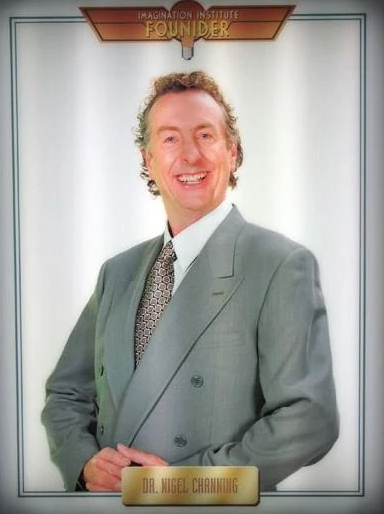
As your vehicle enters the ride, you first hear the disembodied voice of our host – the Imagination Institute’s founder, Dr. Nigel Channing (played by Monty Python’s delightful Eric Idle) – who introduces us to the Imagination Scanner, which will now (you guessed it) “measure your imaginations.” The vehicles advance through a dark tunnel with a glowing red grid projected within. “Relax as the scanner sees what’s in your heads.” As the Omnimovers pull up to mirrored walls, a laser grid is projected across your vehicle as the high-pitched whir of a scan takes measurements of your creativity.
The results are pretty stunning. Ahead, you’ll notice that floating above you in the mirror are fuel gauges reading “empty” and VACANCY signs. Feel good?
“As you can see, there’s not much going on upstairs imagination-wise,” Dr. Channing chuckles, “but that’s just perfect for our experiment.”
In order to rectify our sad, empty imaginations, Dr. Channing has a plan: we’ll tour deeper into the Imagination Institute to engage with a few experiments the team has been working on, all in hopes of kick-starting our creativity. For the next four minutes, we’ll be put through the paces with some of Dr. Channing’s favorite imagination-boosters.
“We begin with an exercise in sound. Listen closely and ‘See What You Hear’!” The vehicles pull into chamber so dark, you can’t make out a hand in front of your face. The darkness seems to go on forever, and in this unusual echo-free chamber, you could hear a pin drop. Stopped for a moment, a bell whistles in the distance… Then a far-away rumbling… It grows louder and louder until high definition surround-sound audio creates the impression of an oncoming train barreling past.
A door ahead slides open as the vehicles continue past our next experiment: “Through the Looking Glass.” Here, a giant magnifying glass appears to be distorting the Institute hallway beyond. But wait… “Is this looking glass actually magnifying? Or is it your imagination?”
As the vehicles continue, a massive cinder block is hoisted high above a glass table for our next experiment: “Shattering Perceptions.” “Here, one quickly learns that when the laws of physics and common sense are shattered…” the cinder block releases, falling toward the table and plunging through it. The sound of shattering glass echoes, though the items on the table stay put. “…Imagination takes over!”
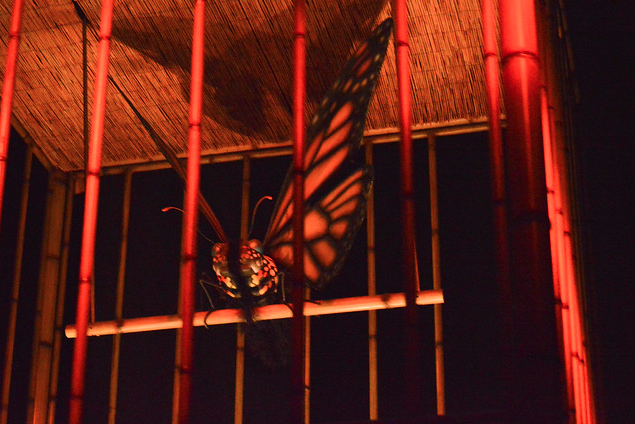
Next up is the Illusion Lab where a unique visual trick seems to make a massive, swinging butterfly appear from nowhere inside of a bamboo cage. “Looks can be deceiving, can’t they?”
Our next experiment: “The Color Of Sound.” The vehicles come to a stop between two long light screens. As the sound of jungle animals echoes, the screens turn green. A countdown and rocket launch turns them red as the vehicle presses on.
As lights flash, the tour moves into a new chamber with glowing points arranged in precise grids. A none-too-well-disguised cameo of Figment adds a bit of insult to injury. As the wall continues on, the dots begin to deviate from their gridded pattern, eventually becoming random points of light in the distance: stars!
“And now,” Dr. Channing offers, “an exercise all about making connections! Stare at these points long enough and your imagination will take flight! You’ll see!” Lines begin to fade in and out, connecting the stars into fish, monkeys, snakes, cats, and more.
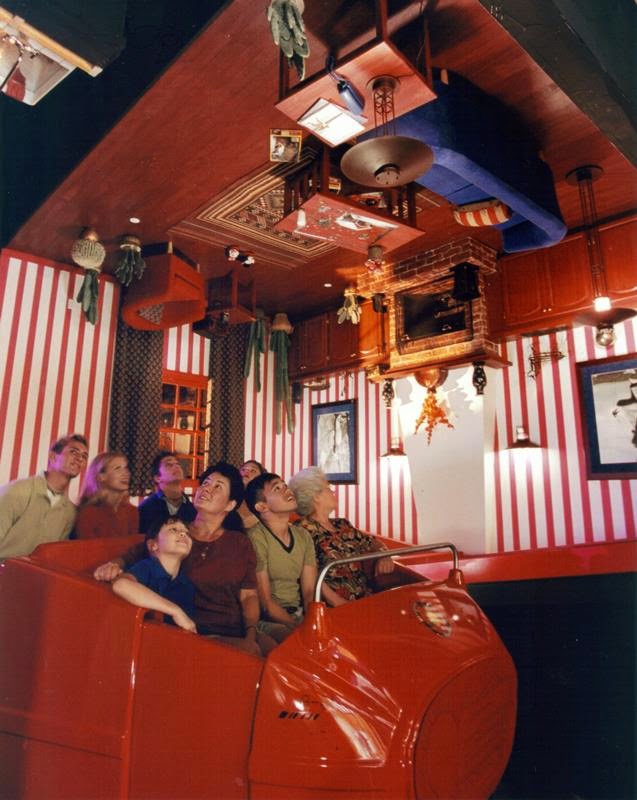
Now, it’s off to the big finale: the “Up is Down” experiment in the Institute’s Gravity Lab. Indeed, this unique finale sees us pass through a garage, living room, bathroom, and kitchen that appear flipped upside down.
Ahead, the pulsing red grid of a dark tunnel appears, signaling our return to the Imagination Scanner. “Well, our experiments are now complete! Time to run you through the Scanner once again. No telling what we’ll find in your imagination this time!”
Once again, the Omnimover aligns with a mirror as the whir of a machine signals the scanner booting up. “This is absolutely unbelievable!” A blast of air from behind sends the rooms into darkness as the mirrors drop away. Beyond, projected lights, images, and eyeballs show just how alive our imaginations have become. “Look! You’ve tested off the charts!”
Now as the vehicles proceeds through a starfield, you hear a familiar, friendly voice… Could it be… Figment?! “Who could’ve imagined! You’re quite clever, all of you!” Dr. Channing agrees. “Congratulations! You’re creative geniuses! What a burst of creativity!”
As the vehicle aligns with the unload area (again, a piece of the former grand opening turntable scene), the Institute’s computerized voice announces, “Reality restored.” Indeed it is. To savor the experience, be sure to watch the full point-of-view video here:
Complaints
Frankly, we don’t have to go on and on about the ride’s shortcomings. You get it.
Its first and most obvious mistake is that nothing could ever justifiably replace Journey into Imagination in the minds and hearts of Disney Parks fans and those who grew up with or were inspired by Epcot. And even if Journey into Imagination did need freshened up for a new millennium, the ride’s core concept – its heart – was timeless. That’s universally agreed upon, so we shouldn’t waste much time contemplating it.
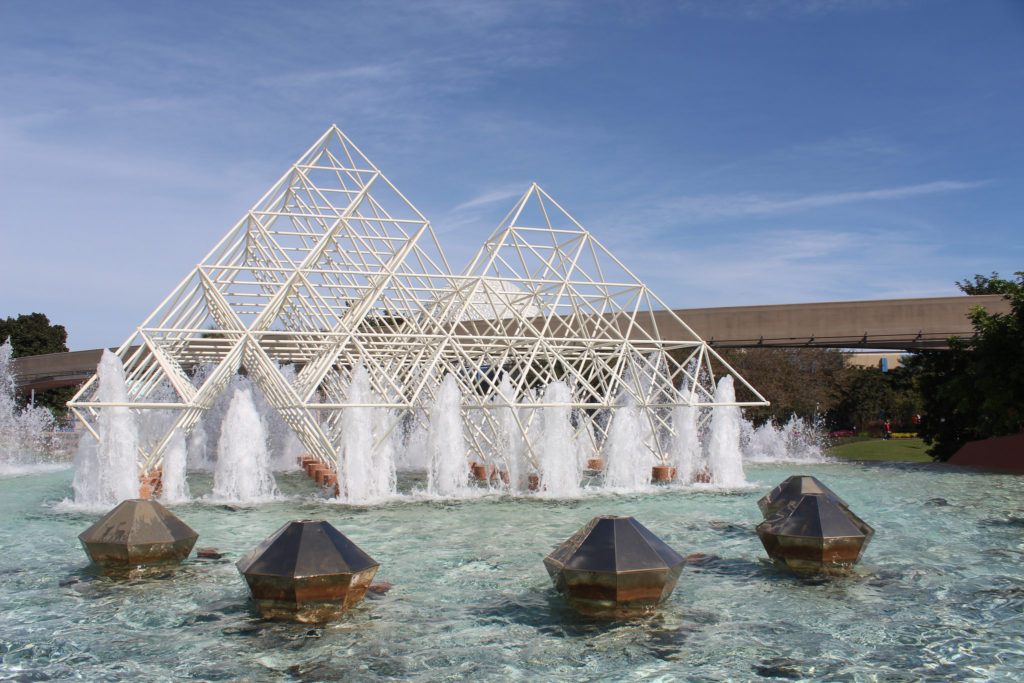
But what is important to point out here is that, even removed from the shadow of its predecessor and accounting for the circumstances that plagued Disney Parks during the cost-cutting era of the 1990s, Journey into Your Imagination just wasn’t a good ride. A repeat offender in our Tell-Tale Signs of a Bad Ride, we’d argue that even if Dreamfinder, Figment, and “One Little Spark” had never existed to begin with, the 1999 Journey into Your Imagination would’ve seemed distinctly un-Disney.
According to Len Testa of the Disney Dish, a March 2000 evaluation of the ride, having surveyed 440 guests, listed among its key findings:
- “25% of guests rate Journey into Your Imagination ‘excellent’ – this rating is the lowest rating of all the attractions at Epcot, and is significantly lower than the previous Journey into Imagination”
- “Over half of the guests had seen the original Journey into Imagination; of them, 2/3 consider the new attraction ‘somewhat [worse]’ or ‘much worse’ than the previous ride.”
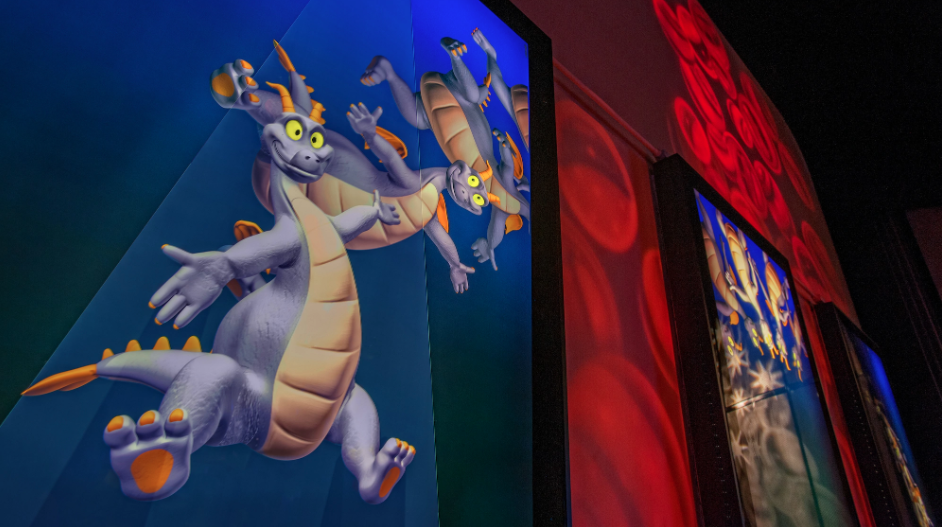
Disney’s own evaluation concluded: “Although there were extremely low ratings received by Journey into Your Imagination, it does appear guests enjoy some aspects of the attraction:” “the train room,” “the gravity room,” and “the butterfly.” “Guests are displeased with the music, the characters, and don’t appear to ‘get’ the story. It is extremely apparent that guests want more of the Figment character.”
Well, whaddayaknow?
Journey into Your Imagination closed two years and one week after it opened – one of the shortest lived Disney rides ever, and a clear sign that Disney and Kodak understood just how disastrous the ride truly was.
Given that a similar fate would soon befall Disney’s California Adventure (where the Declassified Disaster: Superstar Limo closed after just one year with no plans to replace it; the park was simply stronger with no dark ride than with Superstar Limo), it stood to reason that the “Imagination Institute” might simply stay closed forever. But Imagineers had one more chance… On the last page, we’ll explore what happened to the ride and what we expect the future to hold for the Imagination pavilion.


